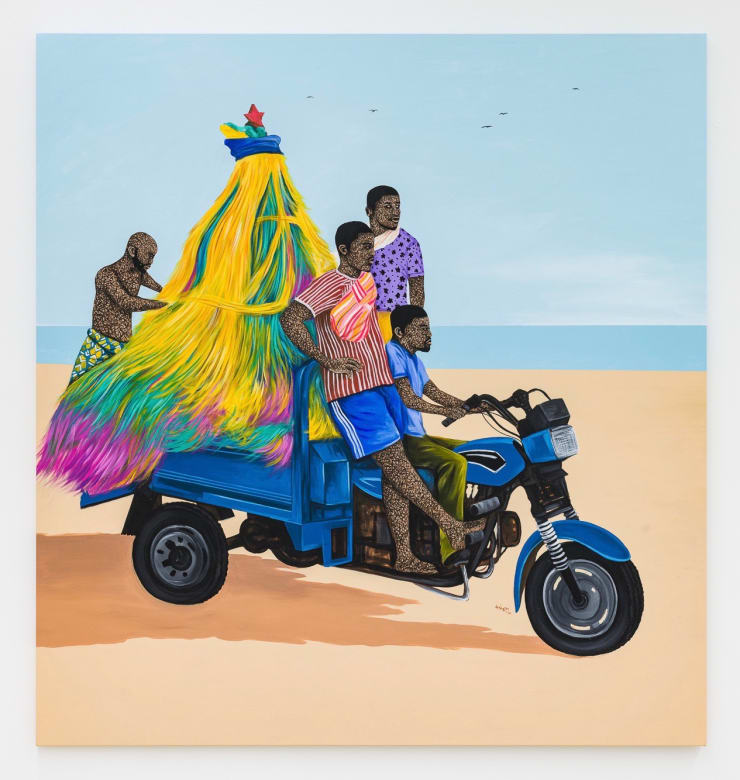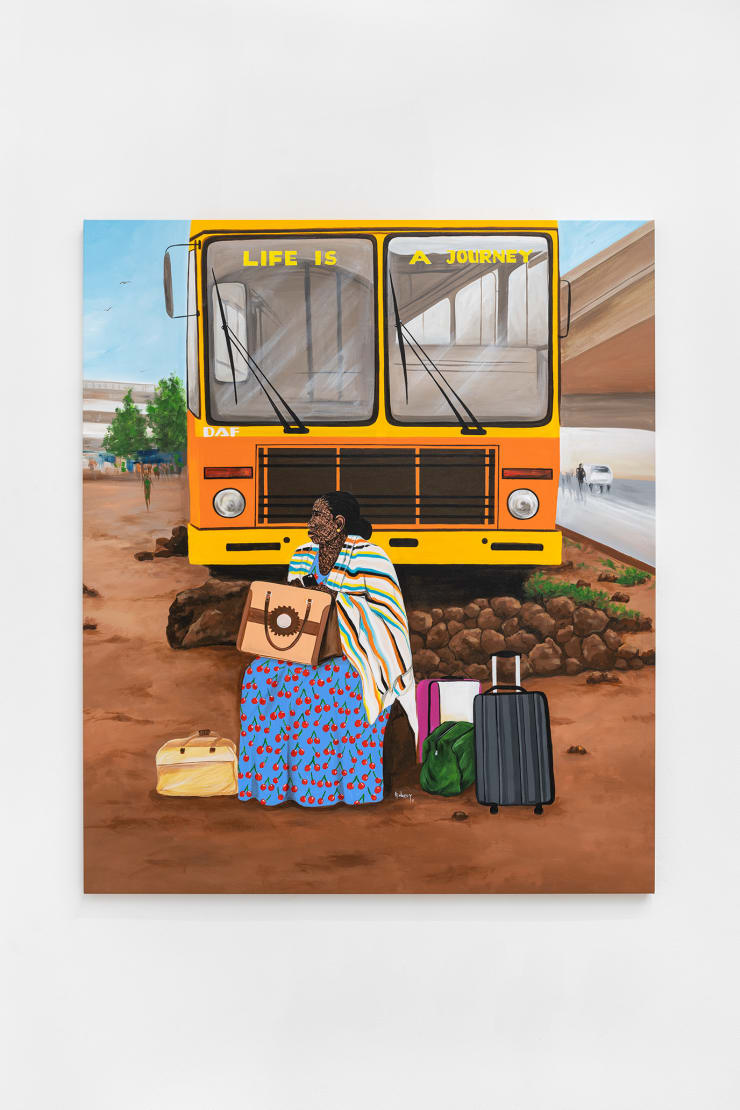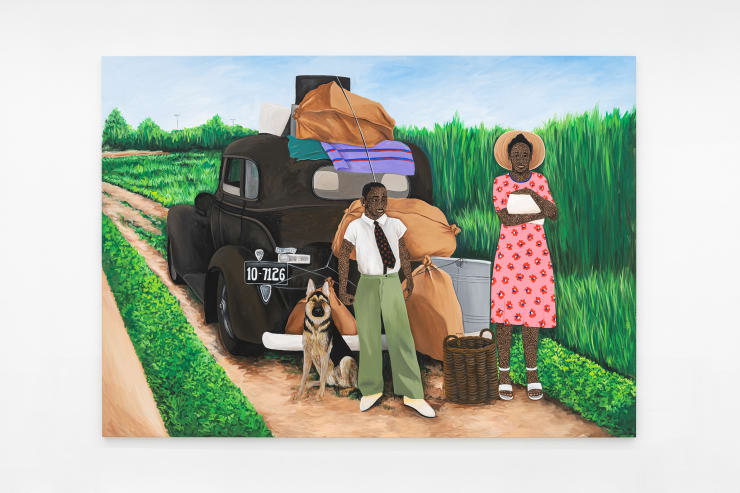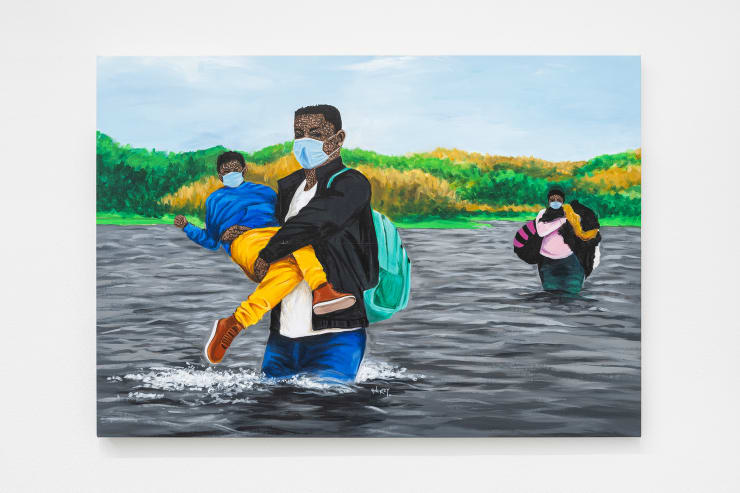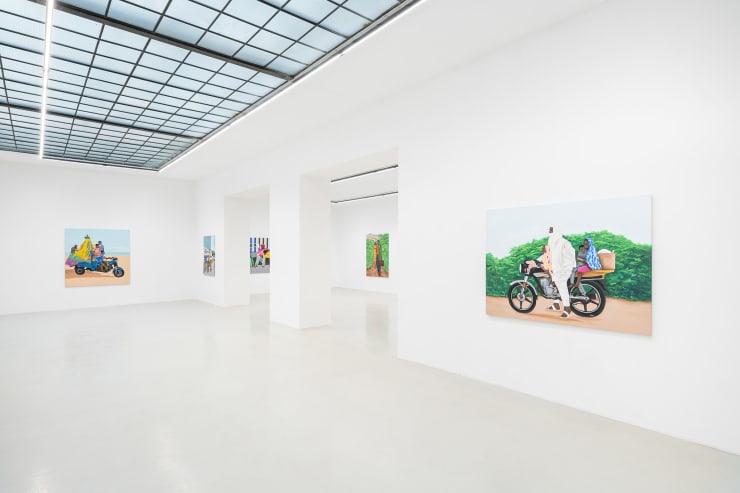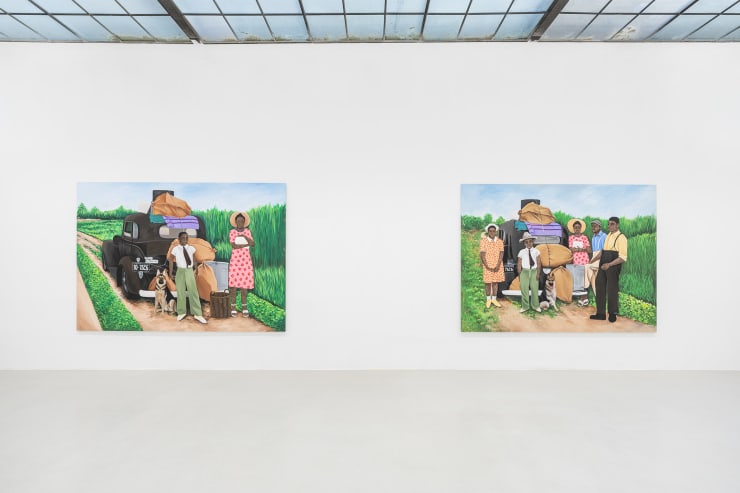Hamid Nii Nortey | Faith in Strangers: Organised by Daniel Lippitsch and David Omari
Faith in Strangers ist Hamid Nii Norteys erste europäische Einzelausstellung, die ihren Fokus auf Norteys neuester Wer- kreihe legt. Diese fesselnde Serie befasst sich dabei mit den vielfältigen sozio-politischen Komplikationen zum Thema Migration, die von historischen Bezügen über Expatriation bis hin zu politischer Verfolgung reichen.
Nortey, ein aufstrebender ghanaischer Künstler und Autodidakt (geb. 1987), entwickelte sein Interesse an der Malerei bereits als Schüler der Mandla Dada-Grundschule in La Accra, Ghana, von welchem Zeitpunkt an er Zeuge der be- trächtlichen Veränderungen in der Stadt wurde. Seine berührenden und farbenfrohen figurativen Gemälde befassen sich eingehend mit der sich schnell entwickelnden sozialen Landschaft Ghanas sowie des Kontinents und beleuchten die diversen sozialen Klassen sowie die daraus resultierenden Entwicklungen der Generationen. Norteys Werke zeich- nen sich durch seine charakteristische Kreuzschraffurtechnik aus, die er auf die Haut seiner Figuren anwendet. Im Ge- gensatz zu der breiten und weichen impressionistischen Farbpalette des Künstlers erzeugen die eng aneinander lie- genden parallelen Linien, die in Abstand und Breite variieren, eine raue, schlaffe organische Textur, die visuelle und taktile Qualitäten der natürlichen Haut vermittelt. Ausgehend von akribischen und spielerischen Skizzen entwickeln sich seine Porträts zu lebensechten und lebendigen visuellen Eindrücken.
.
Organisiert von Daniel Lippitsch und David Omari
-
 Hamid Nii Nortey, Journey into the Heart of West Africa, 2021, Acrylic on Canvas, 170 x 160 cm
Hamid Nii Nortey, Journey into the Heart of West Africa, 2021, Acrylic on Canvas, 170 x 160 cm -
 Hamid Nii Nortey, Escape through the Wilderness, 2021, Acrylic on Canvas, 181 x 135 cm
Hamid Nii Nortey, Escape through the Wilderness, 2021, Acrylic on Canvas, 181 x 135 cm -
 Hamid Nii NorteyAfter a while just living becomes a full-time job, no wonder we need a break,, 2021Acrylic on Canvas138 x 126 cm
Hamid Nii NorteyAfter a while just living becomes a full-time job, no wonder we need a break,, 2021Acrylic on Canvas138 x 126 cm
54 3/8 x 49 5/8 in -
 Hamid Nii NorteyDon’t deport my Mom, 2021Acrylic on Canvas108 x 91 cm
Hamid Nii NorteyDon’t deport my Mom, 2021Acrylic on Canvas108 x 91 cm
42 1/2 x 35 7/8 in -
 Hamid Nii NorteyFulani Pathways, 2021Acrylic on Canvas130 x 171 cm
Hamid Nii NorteyFulani Pathways, 2021Acrylic on Canvas130 x 171 cm
51 1/8 x 67 3/8 in -
 Hamid Nii NorteyLife is Journey, 2021Acrylic on Canvas132 x 112 cm
Hamid Nii NorteyLife is Journey, 2021Acrylic on Canvas132 x 112 cm
52 x 44 1/8 in -
 Hamid Nii NorteyPleasure without Champagne is artificial, 2021Acrylic on Canvas138 x 118 cm
Hamid Nii NorteyPleasure without Champagne is artificial, 2021Acrylic on Canvas138 x 118 cm
54 3/8 x 46 1/2 in -
 Hamid Nii NorteyRescue from the Mediterranean, 2021, 2020Acrylic on Canvas64 x 98 cm
Hamid Nii NorteyRescue from the Mediterranean, 2021, 2020Acrylic on Canvas64 x 98 cm
25 1/4 x 38 5/8 in -
 Hamid Nii NorteySeeking Asylum, 2021Acrylic on Canvas140 x 97 cm
Hamid Nii NorteySeeking Asylum, 2021Acrylic on Canvas140 x 97 cm
55 1/8 x 38 1/4 in -
 Hamid Nii NorteyThe Great Migration 1, 2021Acrylic on Canvas200 x 265 cm
Hamid Nii NorteyThe Great Migration 1, 2021Acrylic on Canvas200 x 265 cm
78 3/4 x 104 3/8 in -
 Hamid Nii NorteyThe Great Migration 2, 2021Acrylic on Canvas200 x 280 cm
Hamid Nii NorteyThe Great Migration 2, 2021Acrylic on Canvas200 x 280 cm
78 3/4 x 110 1/4 in -
 Hamid Nii NorteyThe Struggle of an Illegal Immigrant, 2021Acrylic on Canvas140 x 165 cm
Hamid Nii NorteyThe Struggle of an Illegal Immigrant, 2021Acrylic on Canvas140 x 165 cm
55 1/8 x 65 in -
 Hamid Nii NorteyWaiting in Despair, 2021Acrylic on canvas128 x 101 cm
Hamid Nii NorteyWaiting in Despair, 2021Acrylic on canvas128 x 101 cm
50 3/8 x 39 3/4 in -
 Hamid Nii NorteyWhere do we go from here, 2021Acrylic on Canvas72 x 102 cm
Hamid Nii NorteyWhere do we go from here, 2021Acrylic on Canvas72 x 102 cm
28 3/8 x 40 1/8 in
Hamid Nii Nortey (b. 1987) lives and works in Accra, Ghana. His most recent body of work will be displayed in his first European solo exhibition Faith in Strangers. This compelling series of paintings addresses the diverse socio-political intricacies of migration, spanning from historical references, via expatriatism to political persecution.
Nortey, a self taught emerging Ghanaian artist, developed his interest in painting as a pupil in Mandla Dada basic school in La Accra, Ghana, and stood witness to the city’s considerable transformation from then on. His compelling and colorful figurative paintings delve into Ghana and the continents fast evolving social landscape shedding a light onto its diverse social classes, as well as the resulting generational developments. Nortey’s works are characterized by his signature cross hatching technique which he applies onto the skins of his figures. Contrasting the artist’s broad and smooth Impressionist colour palette, the close-knit parallel lines, varying in spacing and width, create a rough, loose organic texture, conveying the at once visual and tactile qualities of natural skin. Starting from meticulous and playful sketches, his portraits grow into lifelike, and lively, visual impressions.
He reflects upon his engagement with architectural structures to create sceneries of different composition, modern home decor and different image perspectives that resonate and compel his viewers to be physically and emotionally invested in the subjects story.
The exhibition Faith in Strangers is separated into two sections with the first focusing on historical as well contemporary aspects of African and Afro-American migration, which is being resembled by the central work group depicting the Great Migration in the US. The Great Migration described the movement of six million African Americans from rural areas of the Southern states to urban areas in the Northern states between 1916-1970, which was motivated to escape racial violence and pursue economic and educational opportunities in the North. Nortey furthermore discusses forms of African migration in daily situations as well as through the depiction of Fulani Pathways, referring to the ethnic group of the Fulani, who were considered as one of the largest nomadic ethnic groups contributing to the rich cultural landscape of Western Africa.
The second section focuses on the juxtaposition between forced migration and leisure travel to present the significant differences in how Western perception can diverge from African reality. Forced migration being motivated by internal and external conflicts, referring to the refugee crisis over the last years is being portraited in elemental visual forms such as despair, helplessness, violence and death. In conjunction with this, the works After a while just living becomes a full-time job, no wonder we need a break and Pleasure without champagne is artificial deliver a contrasting reality of the economically affluent part of African society and also deliver a tragically self-reflecting irony.
The central dialogue created in Faith in Strangers is being addressed by Nortey’s meticulous analysis to dissect historical, political as well as social aspects of African and Afro-American issues, being expressed through the concept of migration, by displaying it in its violent and joyful reality.
Organised by Daniel Lippitsch and David Omari
-
 Hamid Nii NorteyInstallation View I, Faith in Strangers , 2022
Hamid Nii NorteyInstallation View I, Faith in Strangers , 2022 -
 Hamid Nii NorteyInstallation View II, Faith in Strangers, 2022
Hamid Nii NorteyInstallation View II, Faith in Strangers, 2022 -
 Hamid Nii NorteyInstallation View III, Faith in Strangers , 2022
Hamid Nii NorteyInstallation View III, Faith in Strangers , 2022 -
 Hamid Nii NorteyInstallation View IV, Faith in Strangers, 2022
Hamid Nii NorteyInstallation View IV, Faith in Strangers, 2022 -
 Hamid Nii NorteyInstallation View IX, Faith in Strangers, 2022
Hamid Nii NorteyInstallation View IX, Faith in Strangers, 2022 -
 Hamid Nii NorteyInstallation View V, Faith in Strangers, 2022
Hamid Nii NorteyInstallation View V, Faith in Strangers, 2022 -
 Hamid Nii NorteyInstallation View VI, Faith in Strangers, 2022
Hamid Nii NorteyInstallation View VI, Faith in Strangers, 2022 -
 Hamid Nii NorteyInstallation View VII, Faith In Strangers, 2022
Hamid Nii NorteyInstallation View VII, Faith In Strangers, 2022 -
 Hamid Nii NorteyInstallation View VIII, Faith In Strangers, 2022
Hamid Nii NorteyInstallation View VIII, Faith In Strangers, 2022 -
 Hamid Nii NorteyInstallation View III, Faith in Strangers , 2022
Hamid Nii NorteyInstallation View III, Faith in Strangers , 2022

